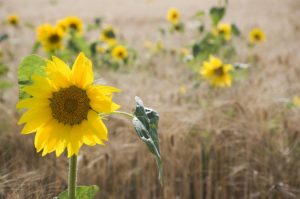Organic agriculture uses a set of techniques to achieve its goals of producing high quality food, free of contaminants, while preserving the natural environment. These techniques are aimed at controlling the factors on which crop growth and agricultural productivity depend, such as: water harvesting and conservation, plant nutrition, pest and disease control, and the management of weeds that may at times limit crop growth. Another important factor is the use of crop varieties adapted to local conditions.
Spatial and temporal diversification, as well as soil protection and the addition of organic matter, are the basic strategies of ecological techniques.
Biodiversity

- Increasing the intraspecific diversity of crops by using different varieties of the same plant species.
- Associating different crops in the same space (crop associations).
- Succession of different crops over time on a plot of land (rotations). The right combination of associations-rotations is the most suitable for the crop, which in many cases can have a considerable increase in yield (Domínguez Gento, A., Roselló Oltra, J., Aguado Sáez, J., 2002).
- Combining with the crop wild species such as hedges or hedgerows and natural vegetation cover, both on the margins and between crops.
- By means of a variant of green cover crops: green manures or cover crops.
- Introducing livestock activity on the farm.
- Fallows: A variation of the rotation method consists in intercalating a period where the land is left uncultivated, the fallow. This allows the soil to rest and thus regain its fertility.
- A high contribution of organic matter: important to promote microbiological diversification and restructuring of the soil.
- Eliminate the use of conventional agrochemicals and reduce the use of other agrochemicals.
Plant protection products allowed in organic agriculture: conventional pesticides tend to damage the natural enemies of pests and are not able to kill phytophagous pests, which develop a certain resistance to them.
Biodiversity has various beneficial effects on the agro-ecosystem such as allelopathic interactions that can promote or inhibit the proliferation of other neighboring plants, health benefits, positive changes in environmental factors, increased productivity, etc.
Benefits of biodiversity in the agroecosystem
- BENEFICIAL ALLELOPATHIC RELATIONSHIPS. Plants release chemicals into the environment with properties that promote or inhibit the development of other plants in their vicinity.
- HEALTH BENEFITS. The more plant diversity that is promoted, the greater the diversity of crop protection animals and the better the control of plant-eating pests. Similarly, the greater the microbiological diversity, the lower the risk of disease. These aspects are complementary because they are often the most important.
The pests themselves are the vectors of disease. - CHANGES IN ENVIRONMENTAL FACTORS: For example, cover crops improve soil structure and thus moisture retention capacity. Hedges also improve the water and heat regime of the system, etc.
ALTERNATIVE PRODUCTION AND INCREASED PRODUCTIVITY: For example, when livestock activity is included in the farm, it tends to close a cycle (recycling of plant by-products and production of manure useful to the crop). The improvement of environmental conditions has an impact on the increase of
productivity. - IMPROVEMENT OF SOILS AND THEIR MICROBIAL ACTIVITY: Contributions of organic matter in the form of mature compost that contribute to strengthening the microbial activity of the soil and improving its properties (texture, structure, CEC, etc.).
- SIMPLICITY ACCIDENTAL HANDLING: When competition increases, weeds are even better controlled.
- REDUCED RISK OF EROSION: By improving the physical properties of the soil and its stability
The roots of roofing plants, hedges, etc. make it more difficult for heavy rain or wind to wash away the soil. - LANDSCAPE IMPROVEMENT: As the number of species, colors, shapes, strata, etc. increase, the landscape will be improved,
the strata, etc., in short, the visual composition of the space is improved. - REDUCTION OF ECONOMIC RISK: By diversifying the commercial offer
Associations of plantations

Crop associations have the following advantages (Domínguez Gento, A., Roselló Oltra, J., Aguado Sáez, J., 2002):
– Higher yields per unit area cultivated. This is measured by the Soil Equivalent Ratio, (RES), which calculates the area of monoculture of each of the associated species that is necessary to obtain the same production from one hectare of the associated species. A good association gives values higher than the unit, a bad one lower values, so it is better to separate these crops.
– Economic security: in subsistence agriculture, it ensures self-sufficiency, reduces the risk of losses due to price fluctuations or damage to one farm, as the other farm compensates for its production.
– More efficient use of resources, higher density of plants intercepts more light, helped by different architecture than monoculture; better use of water, more shade, less direct evaporation and more transpiration through plants; water penetrates better into the soil, erosion is reduced; better use of nutrients when needs are complementary and root systems explore different soil horizons; if there is a legume in the association, it fixes nitrogen and benefits the rest.
– Health benefits and increased pest protection: In addition to the positive effect of increased biological diversity, which generally reduces insect pests, there is also better control of weeds. In addition, the combination of species that are susceptible and resistant to a particular airborne disease in a polyculture reduces the ability of disease organisms to spread. This is due to the increased distance between one host plant and another, because the resistant crops act as a barrier to the movement of organisms, etc.
The disadvantages are as follows:
– This requires good planning.
– They are often labor intensive.
– Limits or prevents mechanization of tasks.
Examples of common horticultural associations:
– Early stage fruit trees + horticultural crops.
– Cereal + legume.
– Tomato + onion.
– Pepper + onion, garlic or cucumber.
– Corn + bean.
– Corn + bean + pumpkin.
– Cabbage + lettuce.
– Onion + lettuce.
– Fruit trees + clover.
